Introduction
Tsunamis are series of the ocean waves with very long wavelengths, hundreds of kilometers away, being brought about by various processes like sub marines, landslides, glacier calving, volcanic eruptions, meteorite impacts but greatly by earthquakes. It is formed in the ocean and big lakes.
Tsunami originated from the Japanese words ‘tsu’ meaning ‘harbor’ and ‘nami’ meaning ‘wave’ to make a ‘harbor wave’. Tsunamis have in the past and present brought catastrophic devastation to property and human death like in North East of Japan, on March 11, 2011. We shall dwell on the Shifts in the Tectonic plates as the reasoning behind the Tsunamis, but we have to understand the concept involved in the movement of the plate tectonics then how the earthquake will be generated to result into tsunami.
Plate Tectonics
These are movements of the lithospheric plates. Tectonics is movement and deformation of the crust, which integrate the ancient theory of continental drift. Plates are the “lithospheric plates which are about 100 kilometers or more” (Earth Quake Museum, 2011, p. 1). Plate tectonics mostly produces earthquake.
It should be noted that, “the earth crust consist of plates sections that float on the molten rock of the mantle” (Earth Quake Museum, 2011, p. 1). The movement of the plates is due to the conventional current. Conventional current is brought about by relationship between the densities of the fluid to its temperature. We can say that convectional current is the flow that transfers heat within a fluid by setting in motion by the heating and cooling of the fluid which changes in its density and continues as long as it heats.
The magma containing material at very high temperatures “rises and spreads on the surfaces creating a new crust which spreads out forming a new plate, until it meets other plates” (Earth Quake Museum, 2011, p. 1). After such a mechanism, “then one of the plates will pushed down into the inferior of the earth and reabsorbed in the mantle; plates can also compress to push up the mountains when they collide or move sideways along the transform faults” (Earth Quake Museum, 2011, p. 1).
The process of plates’ movements is a bit detailed as explained by the Geography site below:
One of the most famous examples of plates sliding past each other is the San Andreas Fault in California. Here the two plates, the Pacific plate and the North American plate both move in a roughly in the northwesterly direction, but one is moving faster than the other. The San Francisco area is prone to many small earthquakes every year as the two plates grind against each other. (Geography site, 2006, p. 1)
Plate Boundaries
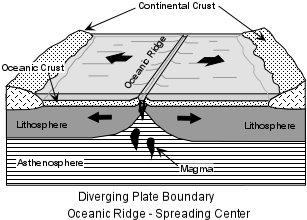
The above diagram shows, “Divergent Boundaries occur at Oceanic Ridges, where new Oceanic lithosphere is formed and moves away from the ridge in opposite directions” (The Earth and Beyond, 2011, p. 1).
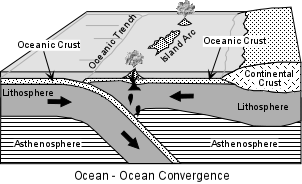
Shown above: “convergent Boundaries occur where oceanic lithosphere is pushed back into the mantle, marked by oceanic trenches and subduction zones” (The Earth and Beyond, 2011, p. 1).
Two types are possible –
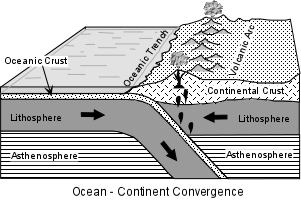
“When two plates of oceanic lithosphere converge oceanic lithosphere is subducted beneath oceanic lithosphere; when ocean lithosphere runs into a plate with continental lithosphere, the oceanic lithosphere is subducted beneath the continental lithosphere” (The Earth and Beyond, 2011, p. 1).
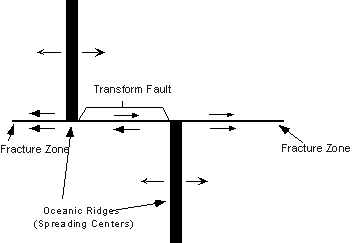
“Transform Boundaries occur where two plates slide past one another horizontally; the San Andreas Fault, in California is a transform fault” (The Earth and Beyond, 2011, p. 1).
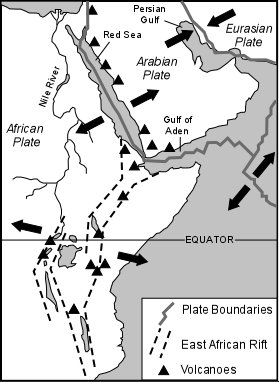
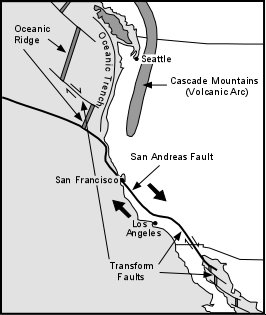
“Continental rifting may create a new divergent margin and evolve into an oceanic ridge, such as is occurring in East Africa and between the African Plate and the Arabian Plate” (The Earth and Beyond, 2011, p. 1).
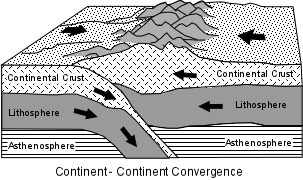
It has been shown that the plates play very significant role in making the earth crust unstable:
Continental lithosphere collide to join two plates together, such as has occurred recently where the Indian Plate has collided with the Eurasian Plate to form the Himalaya Mountains. Plate tectonics explains why earthquakes occur where they do, why volcanoes occur where they do, how mountain ranges form, as well as many other aspects of the Earth. It is such an important theory in understanding how the Earth works. (The Earth and Beyond, 2011, p. 1)
How Earthquake will generate tsunami
After fault has been created the earthquake will occur on it due to the massive violent movement as the two plates compress one another or override one another causing heavy pressure on the underlying rock. This causes vibrations or shockwaves to go through ground. As the solid rock plate moves up beneath the sea, “there is a sudden movement within the crust or mantle and concentric shock waves moves out of that point” (Geography site, 2006, p. 1).
The point of origin is referred as the focus, where in a radius of around 250 miles the effect is greatly felt, and the point directly above the surface is called the epicenter (Geography site, 2006).
A Tsunami is formed when “the sea floor abruptly deforms and vertically displaces the overlying water” (Geography site, 2006, p. 1). Earth’s crust deforms from at points below the ocean consequently disturbing the overlying mass of water. The process continues as thus:
The water above is displaced from its equilibrium position. The waves will be as result of the displacement of the water mass, which act under influence of gravity, to regain its equilibrium position. The potential energy that results from the uplifting or pushing of the water above mean level is then transferred to horizontal propagation of tsunami wave which possess the kinetic energy. (Tsunami, 2011, p. 1)
Tsunamis will results when a large sea floor elevate. Within several minute of earthquake, the initial, panel 1, is split into a tsunami that travels out of the deep ocean and another travelling to the nearby coast (Tsunami, 2011).
The tsunami will be greatly affected as it travels through the ocean where the rate at which the wave loses its energy is related to its wavelength. At deep waters the wave will travel at a very high velocity and as it approached the shoe or as the depth decreases the speed of the wave decreases; however the energy of the wave remains constant.
Conclusion
From the above study, tsunamis are produced or generated by the plate tectonic beside where the movement of the tectonics due to convectional current due to the heat coming from the earth center. This produces the movement of the plate where one plate moves toward the other and collide resulting in the faults being formed. This movement causes a ground shaking movement resulting into elastic waves travelling through the solid earth where one plate is emerged above the other and this causes an upward movement.
The upward movement causes the water above to be displaced, pushing a large volume of water upwards and the potential energy involved is transformed to horizontal kinetic energy which is massive causing formation of a wave of water which is the tsunami. For the last tsunamis they have occurred through this method.
References
Geography site. (2006). What causes an earthquake? Web.
The Earth and beyond. (2011). The earth and beyond, plate tectonics. Web.
The Earthquake Museum. (2011). What causes earthquakes? Web.
Tsunami. (2011). Tsunamis. Web.